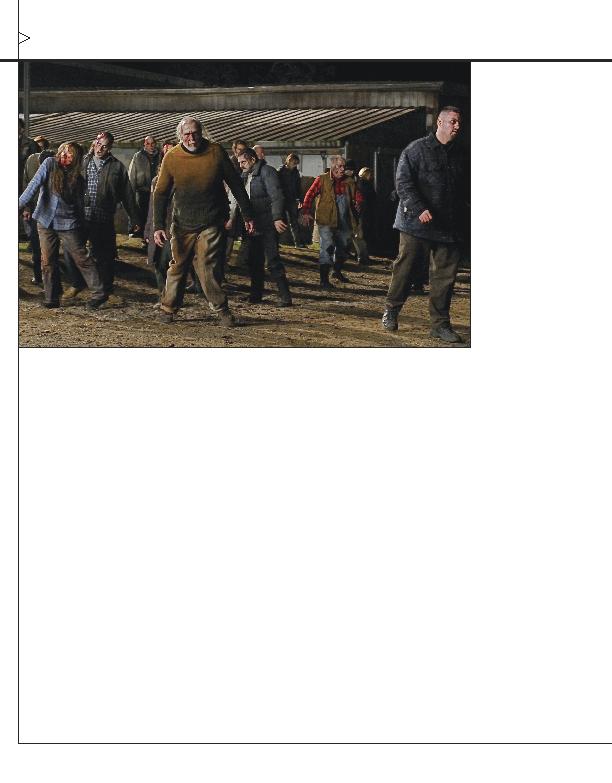
icon George Romero has ever done an actual
sequel to any of his famous Dead movies. "I
wish I could connect everything the way Steve
King did with the town of Castle Rock," the
writer-director says, "but I can't. There are too
many different owners. Different people own
the different copyrights to the different films.
It's only been the last two films, Diary of the
Dead and this one that my partner, Peter
Grunwald, and I have ownership in. So now
we can do what we want."
acters in another movie, but the film per-
formed so well when compared to its small
budget that the producers from Artfire Films
wanted to make a sequel quickly. Romero
soon found himself looking to characters who
only made a brief appearance in that film for
inspriration -- a group of National Guards-
men who rob the main characters at gun-
point. "When I started to write this character
for [actor] Alan Van Sprang, I could do any-
thing I wanted," explains the filmmaker.
seconds. We had no idea who that guy was or
what he was about. So it was almost like writ-
ing a new character." This is Van Sprang's third
film with Romero and the writer-director wist-
fully admits he'd like to pretend the actor was
always playing the same character. To that
end, he decided not to use the name he'd writ-
ten in the script, Crockett, and simply let the
character be known as "Sarge," with the quiet
implication that Van Sprang may have been
playing the same character in all three films
-- something he couldn't do because of copy-
right issues.
the leadership of their sergeant (Van Sprang)
after their superiors make a series of rash and
lethal decisions. An online video clip leads
them to Patrick O'Flynn (Kenneth Welsh), a
former fisherman who offers to lead survivors
of the zombie uprising back to the safety of his
isolated island home. The truth, though, is
that Patrick has been exiled after a series of on-
going arguments with his rival island faction
leader Seamus Muldoon (Richard Fitzpatrick).
what to do with the un-
dead scattered across their
shared island -- kill them
or shelter them in hope of a
future cure? With Sarge and
the National Guardsmen in
tow, O'Flynn heads back to
the island to permanently
settle the long-standing
grudge between the two
families while wiping out
the undead as well.
he did when he first crafted
Night of the Living Dead in
1968: by working from a
loose outline. "I keep little
notepads of ideas that I
don't want to forget," he
explains. "Then I put those
in a sequence and try to fig-
ure out a way to make
those things happen with
some sort of logic. Some of
it is in notes and a lot of it
is just in my head, in con-
versations." When he sits
down to write the script, he
starts on page one and goes
write later scenes or anything like that," the
filmmaker says. "I much prefer to start at the
beginning, go through to the end and then
come back and do surgery on it. I'd much
rather have it written down." Over the years,
he's also found that this process gets him a
polished script much faster. "If I can get it
down on paper within two or three weeks,
then I can take some time to step away from
it and come back and look at it and see it with
a fresher eye. See where it needs salt and where
it needs pepper. To get to a first draft -- or
what I'm willing to publish -- probably takes
five or six weeks." Romero is quick to point
out that he's sometimes spent over a year and
a half polishing scripts in the past when trying
to meet the demands of other parties. "In the
past, maybe to my detriment, I've walked
away from a couple of deals because I didn't
want to go as far as people wanted me to go
with changes."
early development of a script. "Peter is a very
good story editor," the filmmaker says. "We